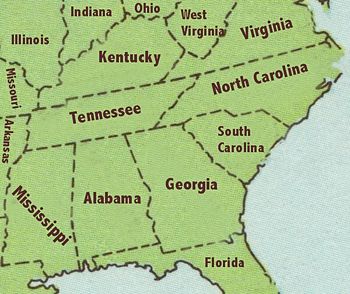Tennessee (U.S. state)
Tennessee is a landlocked state of southeast of the United States. During colonial times (the 1700's), Tennessee was regarded as a western extension of the North Carolina and South Carolina. In 1796, Tennessee became the third state to join the union after the original thirteen colonies. In the American Civil War (1861-1865), Tennessee was one of the eleven states that seceded the United States to form the Confederate States of America.
Tennessee is contiguous to eight other states in the southeast portion of the country. The state is crossed twice north-south by the Tennessee River, dividing it into three parts (West, Middle and East Tennessee) that are geologically distinct. East Tennessee is mountainous (and includes part of the Appalachian Mountains). Middle Tennessee is a rugged plateau, and West Tennessee consists of many small rivers with swamps and rugged hills at a lower elevation.
The state's major cities are Memphis (southwest corner), Nashville (the state capital, in the middle of the state), and in East Tennessee, Knoxville and Chattanooga.
History
Pre 1780
Several Native American tribes occupied the area that would become Tennessee. The most prominent were the Cherokee in the east, the Chickasaw in the west, and the Shawnee and Yuchi in the middle region. The first Europeans to visit Tennessee probably were Spaniards, members of the expeditions of Hernando de Soto (1539-1544) and Juan Pardo (1566-1567). The Spanish built several small forts, but they did not colonize the area.
King Charles II of England included the Tennessee country in the Carolina grants of 1663 and 1665. The first Englishmen to visit the region came to East Tennessee in 1673. In the same year two Frenchmen, Jacques Marquette and Louis Jolliet, landed at the site of Memphis while on a voyage down the Mississippi River. In 1682, another French expedition, under Robert Cavelier, sieur de la Salle, built Fort Prud'homme at the mouth of the Hatchie River in what is now West Tennessee. This rivalry between the British and the French reached a climax in the French and Indian War, which ended in British victory and the withdrawal of the French.
American scouts, notably Daniel Boone, began exploring Tennessee looking for farmland; their first permanent settlement began about 1769. The settlers, coming mainly from the back country of Virginia and North Carolina, were dissatisfied with corrupt and oppressive features of the colonial governments; they were motivated by land hunger and a restless spirit. By 1772, there were four areas of American settlement: one between the forks of the Holston River, near Bristol; another along the Watauga River, in the vicinity of Elizabethton; a third west of the Holston River, near Rogersville; and a fourth along the Nolichucky River, near the present Erwin.
Only the settlement north of the Holston was on land legally ceded by Indians; this area was governed by Virginia until 1779. The other settlers, who were on Indian land, set up their own government, called the Watauga Association, at first leasing the land from the Cherokees and finally purchasing it under the Treaty of Sycamore Shoals in 1775. Under the same treaty, the North Carolina jurist Richard Henderson and his Transylvania Company purchased an immense tract of land in Kentucky and Middle Tennessee from the Cherokees. After Virginia nullified the company's title to Kentucky, Henderson and his associates sponsored the settlement of the Cumberland Valley in the vicinity of Nashville in 1779-1780.
Lynchings after the Civil War
A lynching is the murder of an accused person, often preceded by torture, by three or more killers (99% of whom were never punished or even charged with a crime) who acted under the pretext of service to justice without allowing the accused person to undergo a trial. Lynchings were a form of social control whereby a victim's family, friends, and other community members were forced to adopt a public code of silence about the lynching or fear for their own lives. The identity of lynchers was almost always known, and local police often facilitated the act, and local press often praised it.
Between 1882 and 1930. Tennessee had 214 confirmed lynchings, with 37 white victims, and 177 African American victims.[1] The lynchings occurred mostly in West and Middle Tennessee, likely because these farming areas had a larger population of African Americans than mountainous East Tennessee. The last known lynching was in 1940.
There exists an online catalog[2] of the names/dates/locations of confirmed lynching victims in the state.
